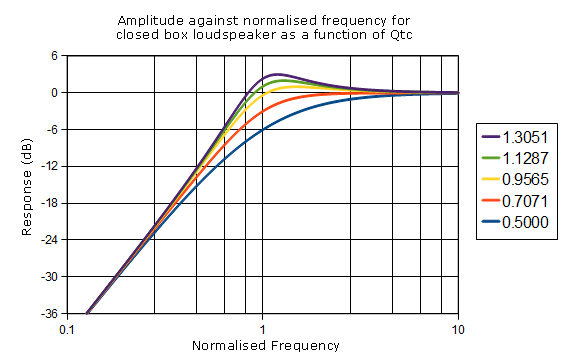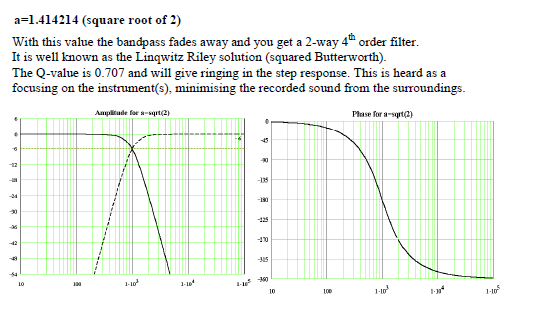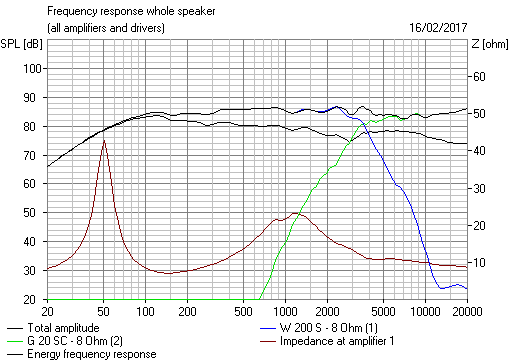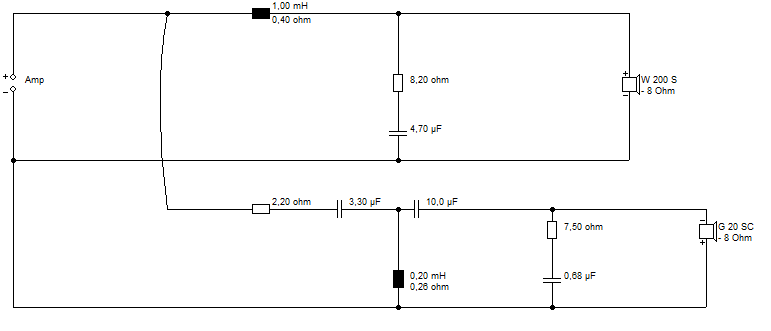system 7, help !!!!!!!!!!
what am i looking at with the technics sb4000's ?
2.5k crossover
tiny 6db woof inductor (basically hf rolloff?)
12db on tweet (out of phase).
They going for acoustic 24db ?
or could it pass a square wave ?
What's going on with the crossover ?
Technics SB-4000
Let's see. 0.68mH on a 8-10" woofer. 4.7uF and 0.56mH on the cone tweeter. Time-aligned maybe, and negative polarity...
I have built a speaker a bit like that:
You are usually trying to get near theoretical slopes like this LR4:
https://www.diyaudio.com/forums/multi-way/147632-classic-monitor-designs-25.html#post4428857
I think I did this similar thing on positive polarity and flat baffle, but it wasn't pretty:
Be easy enough to model it in Boxsim with a simple adjustment to the time alignment (-71mm acoustic centre of the bass, and the -17mm tweeter). Might work out better on phase.
Software | Visaton
I never understand VituixCAD and XSim TBH. All a bit complicated. 😱
Augusts may find a useful resource at SB Acoustics on time alignment. For 6" bass and 1" tweeter it works out around a mere 2cm baffle adjustment. For an 8" bass, it's around 5cm required.
TECH. NOTES - Sbacoustics
my measurement shows 43mm. im gonna go with minimal baffle a slope toward woofer and the tweeter in a seperate box with crossovers in them
Last edited:
I'm thinking cat378
Morel CAT378 Horn Tweeter
With 8" 4ohm sb23 (sb acoustics)
SB Acoustics SB23NRXS45-4
Single 5.6uf cap on tweet, single inductor on woof (2k xover).
Maybe baffle step woof later.
Yea, dispersion doesn't go out 2 octaves for off axis matching.
Mike Chua did a resonant trap for the fs of the tweet.
It it could be a true 6db time/phase setup.
Morel CAT378 Horn Tweeter
With 8" 4ohm sb23 (sb acoustics)
SB Acoustics SB23NRXS45-4
Single 5.6uf cap on tweet, single inductor on woof (2k xover).
Maybe baffle step woof later.
Yea, dispersion doesn't go out 2 octaves for off axis matching.
Mike Chua did a resonant trap for the fs of the tweet.
It it could be a true 6db time/phase setup.
Last edited:
my measurement shows 43mm. im gonna go with minimal baffle a slope toward woofer and the tweeter in a seperate box with crossovers in them
You could really help your cause if you tell us what drivers you are contemplating! Why the secrecy? I am particularly alarmed at your notion of using a 1.3-1.5kHz crossover. That needs an unusually big tweeter IMO. 🙂
@normanbates:
What foolishness is this 6dB stuff? A Morel CAT378 is nowhere near 6dB octave on a single capacitor. Think 12dB/octave:
And you can do even better by correcting the 700Hz Fs resonance:
Finch (Morel CAT378 + Vifa PL18W0-09-08) – AmpsLab
BTW, Mike sent me the Finch circuit, and very clever it is too.
Last edited:
Ah no I am just not used to forums.
I use Peerless
Looking for a Peerless XT25TG30-04 tweeter? - SoundImports
and
SB acoustics
Looking for a SB Acoustics SB23NBACS45-4 woofer? - SoundImports
I would like to try 3order passive filters.
I use Peerless
Looking for a Peerless XT25TG30-04 tweeter? - SoundImports
and
SB acoustics
Looking for a SB Acoustics SB23NBACS45-4 woofer? - SoundImports
I would like to try 3order passive filters.
That SB driver looks like you are entering a World of Hurt to me! 😱
8″ SB23NBACS45-4 / Aluminum - Sbacoustics
4 ohms and horrible metal breakup! 🙄
The XT25 is a familiar and good tweeter, but needs a higher 2.5-3kHz crossover.
I think you could find a better woofer.
8″ SB23NBACS45-4 / Aluminum - Sbacoustics
4 ohms and horrible metal breakup! 🙄
The XT25 is a familiar and good tweeter, but needs a higher 2.5-3kHz crossover.
I think you could find a better woofer.
The tweeeter has a very low resonance
And the sb woofers bresk up is at about 2khz. I think it would work witha a 3rd order filter . Plus I simulated this setup with an active xo at 1,5kHz and everything was fine. Flat response. I am low on budget I cant affford to buy more buy more buy more🙂
And the sb woofers bresk up is at about 2khz. I think it would work witha a 3rd order filter . Plus I simulated this setup with an active xo at 1,5kHz and everything was fine. Flat response. I am low on budget I cant affford to buy more buy more buy more🙂
@normanbates:
What foolishness is this 6dB stuff? A Morel CAT378 is nowhere near 6dB octave on a single capacitor. Think 12dB/octave:
And you can do even better by correcting the 700Hz Fs resonance:
Finch (Morel CAT378 + Vifa PL18W0-09-08) – AmpsLab
BTW, Mike sent me the Finch circuit, and very clever it is too.
Next time you use words like 'foolishness' please take a close look in the mirror before you post.
In the Finch measurements, the raw tweeter curve tracks exactly 6 dB above the tweeter with a capacitor as filter.
I think an excuse would be in order.
For the morel cat378, with the 5.6uf cap, i see (compared to 5k), it is about 6db down at 2k then almost 12db down at 1k. That's partly why I'm obsessed with it. 6db high pass, done. Based on the frequency response, and the drivers 14ohm fs spike, i don't see a foul up in the response that would be seen if the xover is close to the fs. But yes, you can 700hz trap it. Chua was nice enough to send me his crossover of raven/cat, morel plus rs180p, it has the notch at fs.
Technically, the morel 5.6uf xover is @ near 4.7khz, but the horn adds so much lift that it measures flat till 6db down at 2khz. So technically, it would fall into the old 6db recommendation of crossing at least 2 octaves above tweeters fs, so 700hz fs cross no lower than 2.8khz.
The tweet is not perfect, it is 6db down at 10k at 30 degrees off axis.
In laymens terms, at 10khz, it can't quite cover a couch at 7' away.
Devores similar (they say seas drivers) tweet measures dispersion similarly in stereophile reviews.
Now, just need a woof or woofs that would be near the morel 92db, that with a single inductor, would be 6db down at 2khz, then near 12db down at 4khz.
The rival kevlar might work (2 of them) but out of stock, the sb looks like it could work, vifas gone around here, as are peerless ne180w (flatish response to 4k, flattish z curve).
Weird z curves may not be tube amp friendly though.
Old school.
Easy, simple, elegant, no dsp, works for old fuddy duddies like me who still use 30+ year old equipment.
Technically, the morel 5.6uf xover is @ near 4.7khz, but the horn adds so much lift that it measures flat till 6db down at 2khz. So technically, it would fall into the old 6db recommendation of crossing at least 2 octaves above tweeters fs, so 700hz fs cross no lower than 2.8khz.
The tweet is not perfect, it is 6db down at 10k at 30 degrees off axis.
In laymens terms, at 10khz, it can't quite cover a couch at 7' away.
Devores similar (they say seas drivers) tweet measures dispersion similarly in stereophile reviews.
Now, just need a woof or woofs that would be near the morel 92db, that with a single inductor, would be 6db down at 2khz, then near 12db down at 4khz.
The rival kevlar might work (2 of them) but out of stock, the sb looks like it could work, vifas gone around here, as are peerless ne180w (flatish response to 4k, flattish z curve).
Weird z curves may not be tube amp friendly though.
Old school.
Easy, simple, elegant, no dsp, works for old fuddy duddies like me who still use 30+ year old equipment.
Last edited:
I didn't see this point mentioned, and it is something that you should consider if you are trying to "time align" your system:
The crossover filters typically cause a much larger change in the group delay compared to any physical offset. An analog or IIR digital filter imparts some phase change that you cannot separate out or eliminate - it comes along with the amplitude modification of the filter. This phase change/rotation causes group delay (they are a related quantity). So you are stuck with it. It is a mistake, therefore, to try and align the drivers physically before you design the crossover. If you really want the resulting speaker to be time aligned you must do the physical and electrical alignment concurrently. Also, crossover filters of any modest order do not have constant group delay, especially near the filter corner, and trailing away from that. So just moving the driver back and forth in an effort to time align the system is helping at some frequencies and hurting at others.
This section from SL's website is a good read on the effect of the filters on group delay:
Frontiers
You can see in one graph of an LR4@2kHz that at 2kHz the group delay is about 0.15 to 0.17 milliseconds, and this drops off to zero at 20kHz across the tweeter's passband. 0.15 msec is over 2 inches of misalignment! This would be added on top of any physical misalignment of the tweeter on the baffle.
IMHO the only way to REALLY make a time aligned system is to use FIR DSP. But since the ear is just not all that sensitive to phase distortion on musical signals, why bother?
The crossover filters typically cause a much larger change in the group delay compared to any physical offset. An analog or IIR digital filter imparts some phase change that you cannot separate out or eliminate - it comes along with the amplitude modification of the filter. This phase change/rotation causes group delay (they are a related quantity). So you are stuck with it. It is a mistake, therefore, to try and align the drivers physically before you design the crossover. If you really want the resulting speaker to be time aligned you must do the physical and electrical alignment concurrently. Also, crossover filters of any modest order do not have constant group delay, especially near the filter corner, and trailing away from that. So just moving the driver back and forth in an effort to time align the system is helping at some frequencies and hurting at others.
This section from SL's website is a good read on the effect of the filters on group delay:
Frontiers
You can see in one graph of an LR4@2kHz that at 2kHz the group delay is about 0.15 to 0.17 milliseconds, and this drops off to zero at 20kHz across the tweeter's passband. 0.15 msec is over 2 inches of misalignment! This would be added on top of any physical misalignment of the tweeter on the baffle.
IMHO the only way to REALLY make a time aligned system is to use FIR DSP. But since the ear is just not all that sensitive to phase distortion on musical signals, why bother?
My learned friend, vacuphile seemed to have some objection to my stating that 6dB/octave is "Fool's Gold" with any reasonable drivers in a two way like the Finch by Mike Chua:
Finch (Morel CAT378 + Vifa PL18W0-09-08) – AmpsLab
In fact, the order of a filter is decided by the ultimate rolloff. These bass slopes are all second order, 12dB/octave. The only difference is the "Q" of the filter. Orange for Butterworth (BW2 Q=0.707), Blue for Linkwitz-Riley (LR2 Q=0.5). That is what you will find in Mike Chua's splendid Finch design for the tweeter. FWIW, Q has some bearing on time delay.

12dB per octave is minimum for any reasonable tweeter. You also would best keep crossover well away from the Fs resonance of the tweeter (700Hz) and the first breakup of the woofer (5kHz). Mike Chua does that in the Finch. He also notches the Fs and the 5kHz breakup, which is even better.
Lynn Olson explains 12dB/octave as a minimum for tweeters here:
https://www.diyaudio.com/forums/multi-way/190663-sparkling-treble-sibilance-2.html#post2604196
Ideal slopes follow this sort of pattern:


To achieve that on flat baffle I used lower than LR4 filters, because the drivers have a slope of their own too. First order bass, third order tweeter on the crossover. FWIW, LR2 when time-aligned is a negative polarity solution, LR4 is positive polarity.

As Charlie Laub mentioned, it might be best to get the slopes approx LR2 or LR4, then mess with time alignment and tweeter polarity for best fit. Sorry for long post. Lot of topics here. He is also on the money in saying higher order filters give you more wriggle room on phase. 😱
Finch (Morel CAT378 + Vifa PL18W0-09-08) – AmpsLab
In fact, the order of a filter is decided by the ultimate rolloff. These bass slopes are all second order, 12dB/octave. The only difference is the "Q" of the filter. Orange for Butterworth (BW2 Q=0.707), Blue for Linkwitz-Riley (LR2 Q=0.5). That is what you will find in Mike Chua's splendid Finch design for the tweeter. FWIW, Q has some bearing on time delay.
12dB per octave is minimum for any reasonable tweeter. You also would best keep crossover well away from the Fs resonance of the tweeter (700Hz) and the first breakup of the woofer (5kHz). Mike Chua does that in the Finch. He also notches the Fs and the 5kHz breakup, which is even better.
Lynn Olson explains 12dB/octave as a minimum for tweeters here:
https://www.diyaudio.com/forums/multi-way/190663-sparkling-treble-sibilance-2.html#post2604196
Ideal slopes follow this sort of pattern:
To achieve that on flat baffle I used lower than LR4 filters, because the drivers have a slope of their own too. First order bass, third order tweeter on the crossover. FWIW, LR2 when time-aligned is a negative polarity solution, LR4 is positive polarity.
As Charlie Laub mentioned, it might be best to get the slopes approx LR2 or LR4, then mess with time alignment and tweeter polarity for best fit. Sorry for long post. Lot of topics here. He is also on the money in saying higher order filters give you more wriggle room on phase. 😱
Roll off is determined by comparing the filtered with the unfiltered response and after the bend this is minus 6dB/octave for a first order filter. Always. No reason to sow confusion.
Edit, the shape of the bend is determined by the filter Q, but the Q of a first order filter is fixed so shape of the bend is also fixed as in always the same. Norman intended to filter with a single cap, hence this discussion. Now, if the the xover frequency is high enough, it is entirely possible to mount a tweeter this way. However, that would require a rather small midrange to heep the power respons OK, or a waveguide on the tweeter, which should go really low wothout distortion.
So, I agree with Steve that a first order xover is for special cases only, and that the practical minimum is 2nd order.
Edit, the shape of the bend is determined by the filter Q, but the Q of a first order filter is fixed so shape of the bend is also fixed as in always the same. Norman intended to filter with a single cap, hence this discussion. Now, if the the xover frequency is high enough, it is entirely possible to mount a tweeter this way. However, that would require a rather small midrange to heep the power respons OK, or a waveguide on the tweeter, which should go really low wothout distortion.
So, I agree with Steve that a first order xover is for special cases only, and that the practical minimum is 2nd order.
Last edited:
There is no way I can get the 1/4 or even 1/5 of wavelength between speaker centers even ar 1,3kHz
I agree, true 6db is only special case (usually pricy too ! ), absolutely, especially for a 2-way.
Thank for the 12db link, ill read later tonight.
Still, good conversation, lot to digest here.
Thank for the 12db link, ill read later tonight.
Still, good conversation, lot to digest here.
Could you connect a decent full range driver to one channel, your two way ( to be tested ) to the other, then play a slow sine sweep with your head positioned so the two way is just louder, if there's a dip in response the sound will apear to shift to the full range, then back again.
Having mulled this over, Augusts, it pains me to say you have chosen terrible drivers here. 😱
This 8" 4 ohm metal one is a complete horror for midbass duties:
8″ SB23NBACS45-4 / Aluminum - Sbacoustics
Couple that with a Vifa XT25-30 which is the same as a Scan R2604, and not very good below 2.5kHz and you will I think be disappointed.
You will be attempting to build a SEAS Trym with more difficult drivers:
TRYM
Time alignment thrown into the equation, and you should be contemplating less loud midbasses into projects like these:
18W-8434G00
SBAcoustics-61-NRXC
No apologies from me. Just the cold hard equations.
This 8" 4 ohm metal one is a complete horror for midbass duties:
8″ SB23NBACS45-4 / Aluminum - Sbacoustics
Couple that with a Vifa XT25-30 which is the same as a Scan R2604, and not very good below 2.5kHz and you will I think be disappointed.
You will be attempting to build a SEAS Trym with more difficult drivers:
TRYM
Time alignment thrown into the equation, and you should be contemplating less loud midbasses into projects like these:
18W-8434G00
SBAcoustics-61-NRXC
No apologies from me. Just the cold hard equations.
- Home
- Loudspeakers
- Multi-Way
- Time aligning tweeter